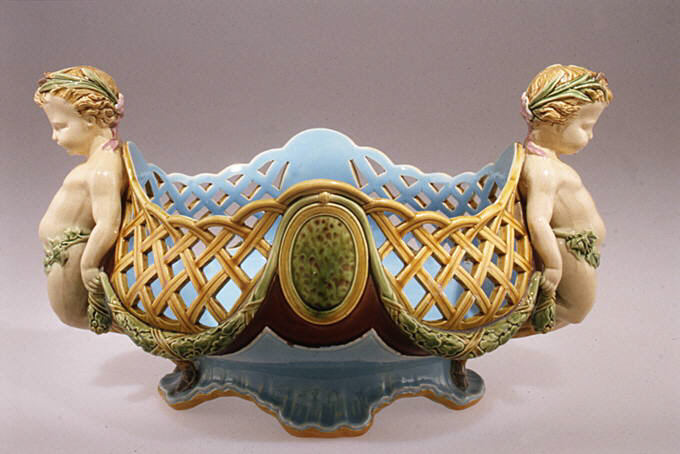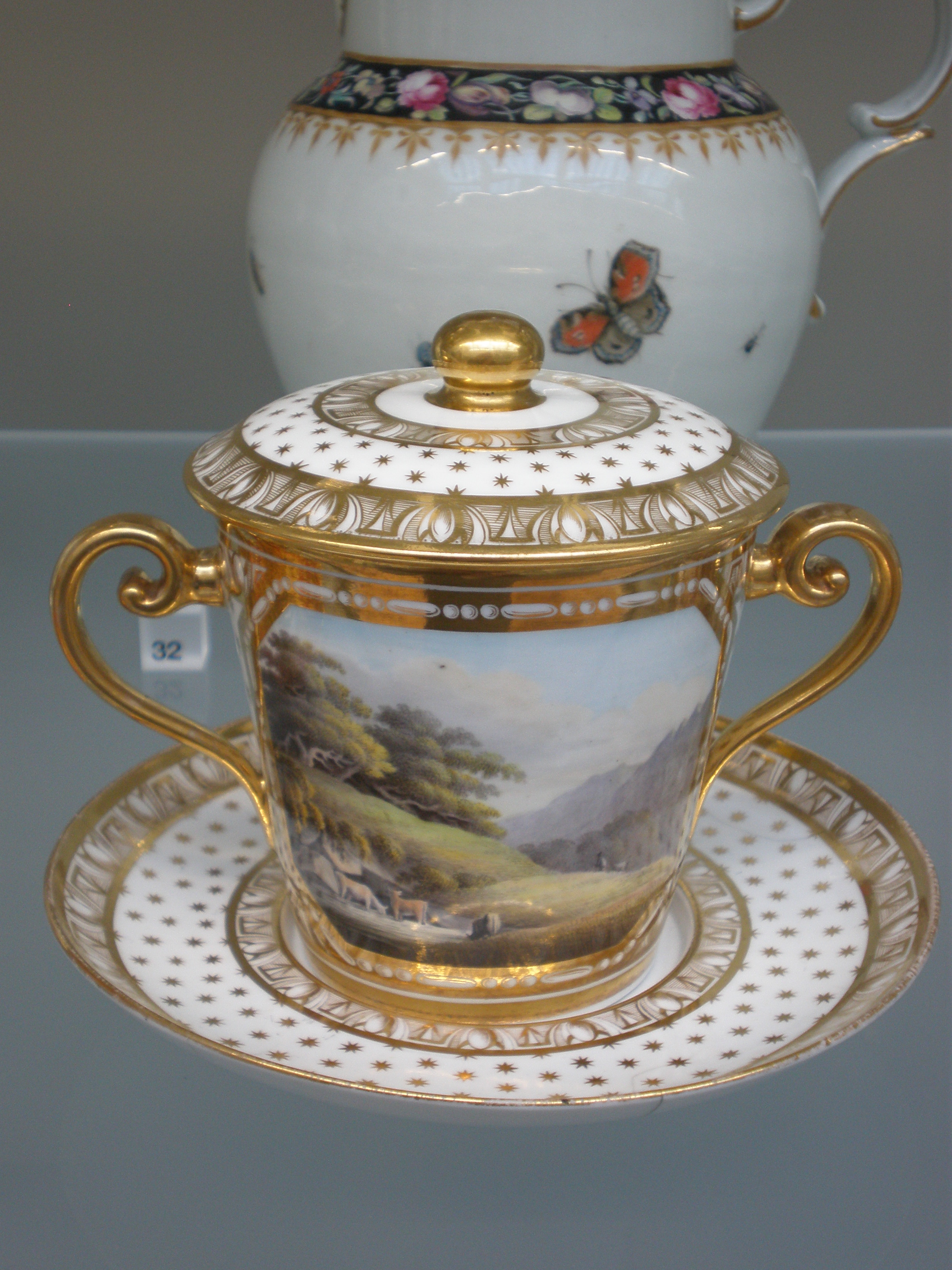|
Thomas Minton
Thomas Minton (1765–1836) was an English potter. He founded Thomas Minton & Sons in Stoke-on-Trent, Staffordshire, which grew into a major ceramic manufacturing company with an international reputation. During the early 1780s Thomas Minton was an apprentice engraver at the Caughley Pottery Works in Shropshire, under the proprietorship of Thomas Turner, working on copperplate engravings for the production of transferware. The engraver Thomas Lucas went from there to work for Josiah Spode at Stoke-on-Trent in 1783, taking some elements of the fashionable chinoiserie patterns with him. While at Caughley Thomas Minton is thought to have worked on chinoiserie landscape patterns including willows, and to have prepared copperplates of them: but the Salopian works never produced the standard willow pattern which includes the bridge and the fence in the foreground. Minton left the Caughley works in 1785, and married Sarah in London in 1789. In 1793 he established his own pottery fa ... [...More Info...] [...Related Items...] OR: [Wikipedia] [Google] [Baidu] |
Spode
Spode is an English brand of pottery and homewares produced by the company of the same name, which is based in Stoke-on-Trent, England. Spode was founded by Josiah Spode (1733–1797) in 1770, and was responsible for perfecting two extremely important techniques that were crucial to the worldwide success of the English pottery industry in the century to follow. He perfected the technique for transfer printing in underglaze blue on fine earthenware in 1783–1784 – a development that led to the launch in 1816 of Spode's Blue Italian range, which has remained in production ever since. Josiah Spode is also often credited with developing, around 1790, the formula for fine bone china that was generally adopted by the industry. His son, Josiah Spode II, was certainly responsible for the successful marketing of English bone china. In 2008 the Copeland Spode company went through some financial troubles. Later the company was picked up by the Portmeirion group. The famous Spode ... [...More Info...] [...Related Items...] OR: [Wikipedia] [Google] [Baidu] |
English Potters
English usually refers to: * English language * English people English may also refer to: Peoples, culture, and language * ''English'', an adjective for something of, from, or related to England ** English national identity, an identity and common culture ** English language in England, a variant of the English language spoken in England * English languages (other) * English studies, the study of English language and literature * ''English'', an Amish term for non-Amish, regardless of ethnicity Individuals * English (surname), a list of notable people with the surname ''English'' * People with the given name ** English McConnell (1882–1928), Irish footballer ** English Fisher (1928–2011), American boxing coach ** English Gardner (b. 1992), American track and field sprinter Places United States * English, Indiana, a town * English, Kentucky, an unincorporated community * English, Brazoria County, Texas, an unincorporated community * En ... [...More Info...] [...Related Items...] OR: [Wikipedia] [Google] [Baidu] |
1836 Deaths
Events January–March * January 1 – Queen Maria II of Portugal marries Prince Ferdinand Augustus Francis Anthony of Saxe-Coburg-Gotha. * January 5 – Davy Crockett arrives in Texas. * January 12 ** , with Charles Darwin on board, reaches Sydney. ** Will County, Illinois, is formed. * February 8 – London and Greenwich Railway opens its first section, the first railway in London, England. * February 16 – A fire at the Lahaman Theatre in Saint Petersburg kills 126 people."Fires, Great", in ''The Insurance Cyclopeadia: Being an Historical Treasury of Events and Circumstances Connected with the Origin and Progress of Insurance'', Cornelius Walford, ed. (C. and E. Layton, 1876) p76 * February 23 – Texas Revolution: The Battle of the Alamo begins, with an American settler army surrounded by the Mexican Army, under Santa Anna. * February 25 – Samuel Colt receives a United States patent for the Colt revolver, the first revolving barrel multishot firearm. * March ... [...More Info...] [...Related Items...] OR: [Wikipedia] [Google] [Baidu] |
1765 Births
Events January–March * January 23 – Prince Joseph of Austria marries Princess Maria Josepha of Bavaria in Vienna. * January 29 – One week before his death, Mir Jafar, who had been enthroned as the Nawab of Bengal and ruler of the Bengali people with the support and protection of the British East India Company, abdicates in favor of his 18-year-old son, Najmuddin Ali Khan. * February 8 – ** Frederick the Great, the King of Prussia, issues a decree abolishing the historic punishments against unmarried women in Germany for "sex crimes", particularly the ''Hurenstrafen'' (literally "whore shaming") practices of public humiliation. **Isaac Barré, a member of the British House of Commons for Wycombe and a veteran of the French and Indian War in the British American colonies, coins the term "Sons of Liberty" in a rebuttal to Charles Townshend's derisive description of the American colonists during the introduction of the proposed Stamp Act. MP Barr ... [...More Info...] [...Related Items...] OR: [Wikipedia] [Google] [Baidu] |
James Northcote (painter)
James Northcote (22 October 1746, in Plymouth – 13 July 1831, in London) was a British painter. Life and work Northcote was born in Plymouth, and was apprenticed to his father, Samuel Northcote, a watchmaker. In his spare time, he drew and painted. In 1769 he left his father's work and set up as a portrait painter. Four years later he went to London and was admitted as a pupil into the studio and house of Sir Joshua Reynolds. At the same time he attended the Royal Academy schools. In 1775 he left Reynolds' studio, and about two years later, having made some money by portrait painting back in Devon, he went to study in Italy. On his return to England, three years later, he revisited his native county, then settled in London, where John Opie and Henry Fuseli were his rivals. He was elected associate of the Academy in 1786, and full academician in the following spring. The ''Young Princes Murdered in the Tower'', his first important work on a historical subject, dates from 178 ... [...More Info...] [...Related Items...] OR: [Wikipedia] [Google] [Baidu] |
Mintons
Mintons was a major company in Staffordshire pottery, "Europe's leading ceramic factory during the Victorian era", an independent business from 1793 to 1968. It was a leader in ceramic design, working in a number of different ceramic bodies, decorative techniques, and "a glorious pot-pourri of styles - Rococo shapes with Oriental motifs, Classical shapes with Medieval designs and Art Nouveau borders were among the many wonderful concoctions". As well as pottery vessels and sculptures, the firm was a leading manufacturer of tiles and other architectural ceramics, producing work for both the Houses of Parliament and United States Capitol. The family continued to control the business until the mid-20th century. Mintons had the usual Staffordshire variety of company and trading names over the years, and the products of all periods are generally referred to as either "Minton", as in "Minton china", or "Mintons", the mark used on many. Mintons Ltd was the company name from 1879 ... [...More Info...] [...Related Items...] OR: [Wikipedia] [Google] [Baidu] |
Bone China
Bone china is a type of ceramic that is composed of bone ash, feldspathic material, and kaolin. It has been defined as "ware with a translucent body" containing a minimum of 30% of phosphate derived from animal bone and calculated calcium phosphate. Bone china is the strongest of the porcelain or china ceramics, having very high mechanical and physical strength and chip resistance, and is known for its high levels of whiteness and translucency.Ozgundogdu, Feyza Cakir. “Bone China from Turkey” Ceramics Technical; May2005, Issue 20, p29-32. Its high strength allows it to be produced in thinner cross-sections than other types of porcelain. Like stoneware, it is vitrified, but is translucent due to differing mineral properties. In the mid-18th century, English potters had not succeeded in making hard-paste porcelain (as made in East Asia and Meissen porcelain), but found bone ash a useful addition to their soft-paste porcelain mixtures, giving strength. This became standard at th ... [...More Info...] [...Related Items...] OR: [Wikipedia] [Google] [Baidu] |
William Greatbatch
William Greatbatch (Circa 1735 to circa 29 April 1813) was a noted potter at Fenton, Staffordshire, from the mid-eighteenth to the beginning of the nineteenth centuries. Fenton was one of the six towns of the Staffordshire Potteries, which were joined in the early 20th century to become the city of Stoke-on-Trent in Staffordshire, England. North Staffordshire became a centre of ceramic production in the early 17th century, due to the local availability of clay, salt, lead and coal. The nature and scale of local pottery production changed dramatically during the course of the 18th century as part of the Industrial Revolution. Greatbatch served as an apprentice to Thomas Whieldon at Fenton Vivian before setting up as an independent manufacturer. He developed and supplied wares to Josiah Wedgwood during a business partnership lasting some twenty years and later, following a bankruptcy, worked directly for Wedgwood at the Etruria works until his retirement. Greatbatch was especia ... [...More Info...] [...Related Items...] OR: [Wikipedia] [Google] [Baidu] |




.jpg)